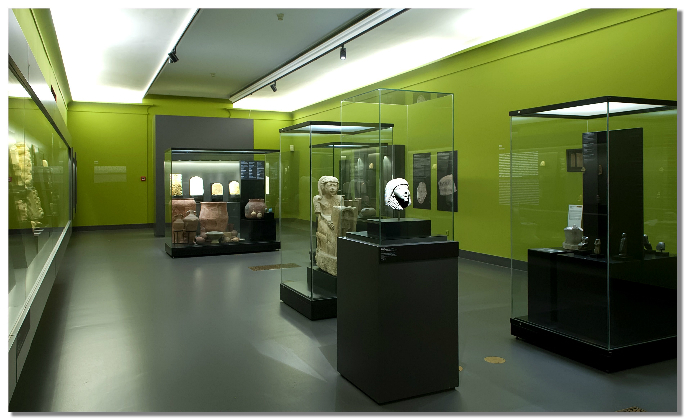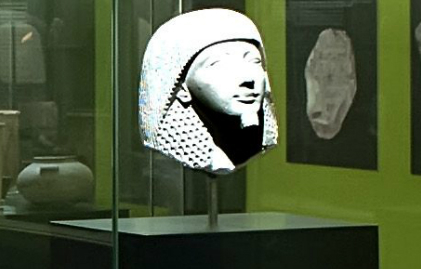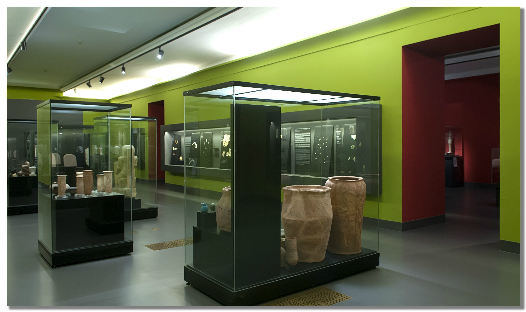The sphere of humans
OBJECT
The rearranged Egyptian Exhibition in the Museum of Fine Art places the objects into a different perspective.
| Dr. Liptay Éva |
2014-06-28 11:00 |
The exhibition breaks away from the traditional chronological approach and creates topical groups placing the objects into their ancient Egyptian context.
The exhibition space is divided into three parts and these sections depict the worlds of humans, gods and the dead respectively. According to the Egyptian world view, these three groups populated the universe: the earth, the sky and the underworld. The Egyptians clearly distinguished these spheres, but it did not mean that these were entirely separated from each other. There were passages between them and the new exhibition wants to focus on these.

Humans
The green background colour of the first room does not only refer to the natural environment of the people who used to live in the Nile valley, but also evokes the colour symbolism of the ancient Egyptian art, in which green symbolised the re-birth of the vegetation as well as that of humans after their death.
 The first topic of the exhibition highlights the creation, which was regarded as the passage from non-being to being. Within the process of creation there were several important moments: the appearance of the creating god, the first land, the first divine creatures emerging from the water, the separation of the earth and the sky or the first appearance of the solar deity on the dawning horizon. The separation of the sky and the earth is depicted by a fragment of a coffin which features the sky in the form of the goddess Nut and the god Shu, who transmitted air and sunlight to the earthly creatures from the gods.
The first topic of the exhibition highlights the creation, which was regarded as the passage from non-being to being. Within the process of creation there were several important moments: the appearance of the creating god, the first land, the first divine creatures emerging from the water, the separation of the earth and the sky or the first appearance of the solar deity on the dawning horizon. The separation of the sky and the earth is depicted by a fragment of a coffin which features the sky in the form of the goddess Nut and the god Shu, who transmitted air and sunlight to the earthly creatures from the gods.
The next topic focuses on the pharaoh, since the ruler, due to his divine descendance, was responsible for communication between humans and gods. For humans he was the token of peaceful welfare, while gods expected him to help maintain the divine world order. The places for communication with gods were the shrines of the temples, where the god, to whom the temple was dedicated, had their statue and where only the pharaoh was allowed to enter to perform the necessary rituals. In practice, however, these rituals were performed by the clergy appointed by the ruler, nevertheless in the temple wall-paintings it is always the pharaoh who does the ritual. All the statues depicting the pharaoh kneeling refer to this role of the ruler. In the exhibition, besides a small bronze sculpture, a life-size head of a pharaoh also represents this type. The latter is a fragment and a drawn reconstruction helps the visitor imagine the original in its entirety.

The hieroglyphic writing can also be seen as a channel of communication between the human world and the gods, since hieroglyphs, to the ancient Egyptian mind, were created by the gods, establishing the ideal picture of a creature, object or phenomenon. In this way, hieroglyphs symbolised the perfection of the universe as it was created by the gods. Hence these signs for the Egyptians carried magical power, and were used in different rituals for example for healing. The magical papyrus exhibited here contains magical texts which were recited to drive away different illnesses that caused a headache.
Magic was another way to communicate with the gods. Humans were presented with this to “rule over the events of life”. These rituals were performed at home and not in the shrines of the temples, since ordinary people were strictly forbidden to enter there. Magical interventions were applied in the crises of life: when a baby was being born, when somebody was ill, or when they wanted to triumph over real or demonic enemies. In the first room the magic stick from the period of the Middle Kingdom was deployed when they wanted to protect the mother and the newborn baby while the horus-steles offered protection against the bites of dangerous animals.
One of the most important symbols that helped the communication with the gods and with the dead was the stele made of wood or stone and erected in tombs, temples or sacred areas. Steles in the first room very visibly show the communication itself that took place during making a sacrifice. On one side of the abundant sacrificial table sat the people who offered the sacrifice, on the other side the recipient. The texts on the stele are sacrificial prayers, which were recited during the ritual and by this the event was magically evoked and done. The ancient bust exhibited together with the steles is a very unique piece: it symbolised the ancestor of a family or a settlement who was supposed to mediate between the living, the dead and the world of gods.